Impact of Interest Rate Changes on UK Economy: A Macroeconomic Report
VerifiedAdded on 2020/10/22
|8
|1346
|435
Report
AI Summary
This report delves into the macroeconomic trends influencing the UK economy, with a specific focus on the Bank of England's decisions regarding interest rate adjustments. It explores the motivations behind these changes, including addressing inflation, managing borrowing, and supporting the pound. The report then examines the effects of these interest rate hikes on various sectors, such as the housing market, consumer spending, and investment, providing graphical representations to illustrate these impacts. The analysis considers how increased interest rates can lead to decreased housing loan demand, reduced consumer spending, and increased investment due to higher potential returns. The report concludes by summarizing the key findings and implications of these macroeconomic dynamics.
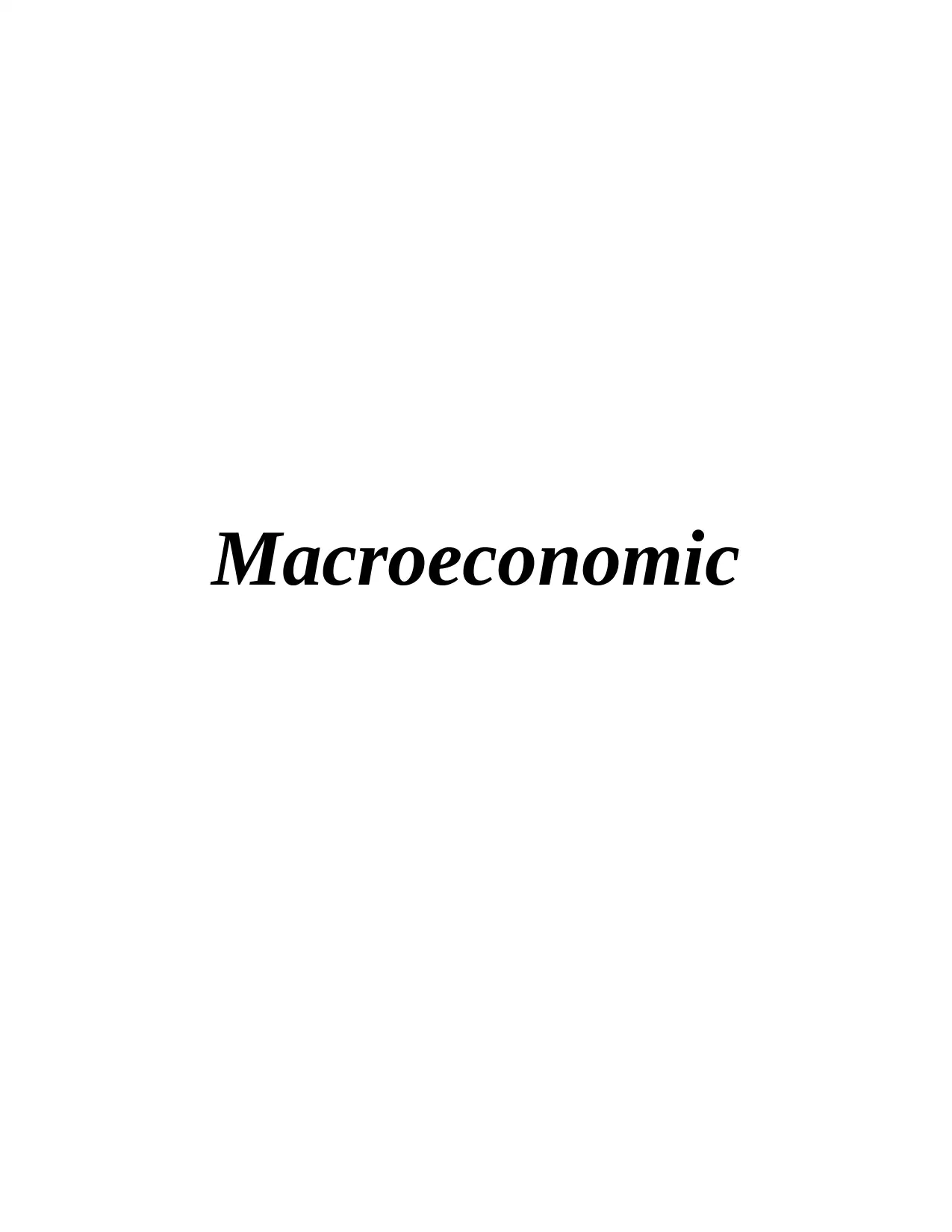
Macroeconomic
Paraphrase This Document
Need a fresh take? Get an instant paraphrase of this document with our AI Paraphraser
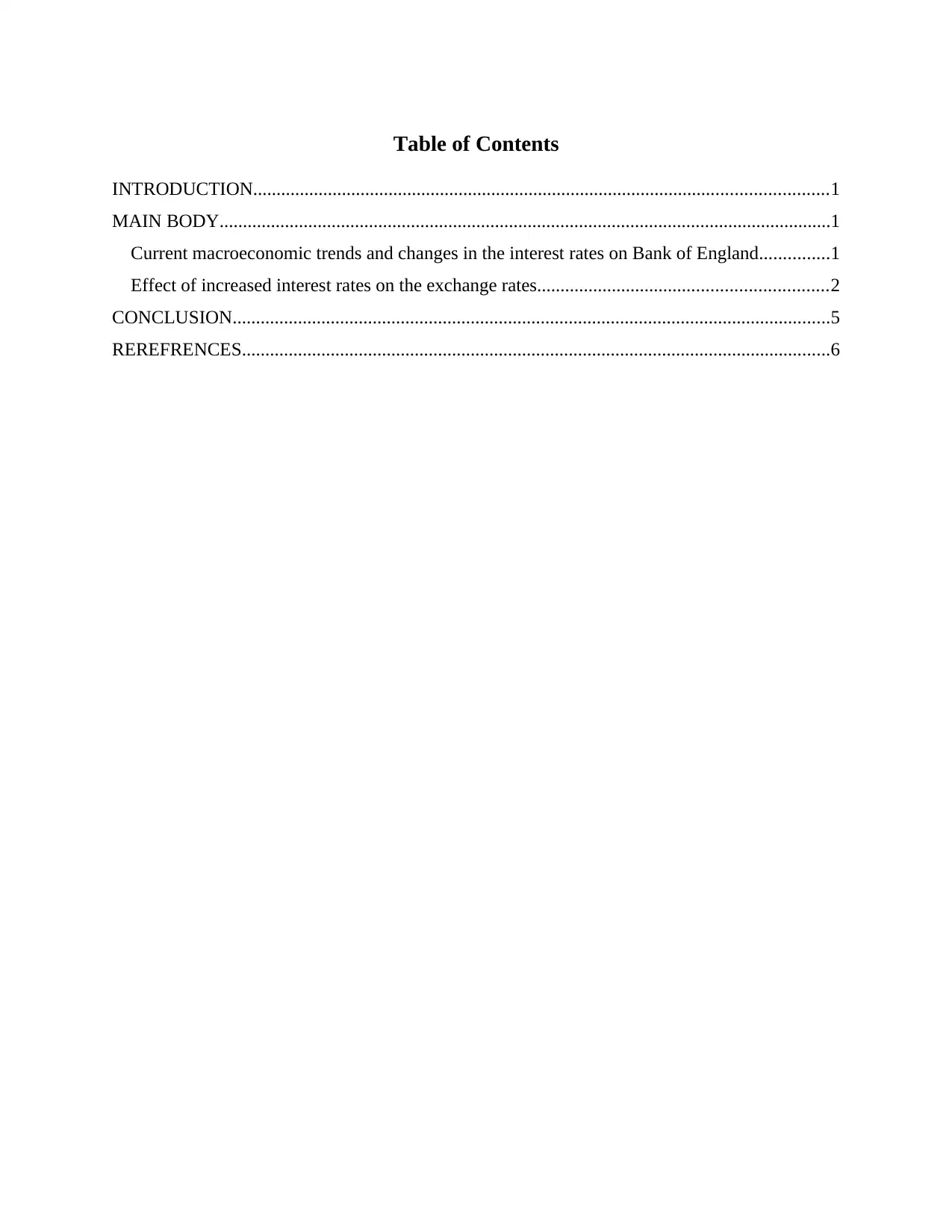
Table of Contents
INTRODUCTION...........................................................................................................................1
MAIN BODY...................................................................................................................................1
Current macroeconomic trends and changes in the interest rates on Bank of England...............1
Effect of increased interest rates on the exchange rates..............................................................2
CONCLUSION................................................................................................................................5
REREFRENCES..............................................................................................................................6
INTRODUCTION...........................................................................................................................1
MAIN BODY...................................................................................................................................1
Current macroeconomic trends and changes in the interest rates on Bank of England...............1
Effect of increased interest rates on the exchange rates..............................................................2
CONCLUSION................................................................................................................................5
REREFRENCES..............................................................................................................................6
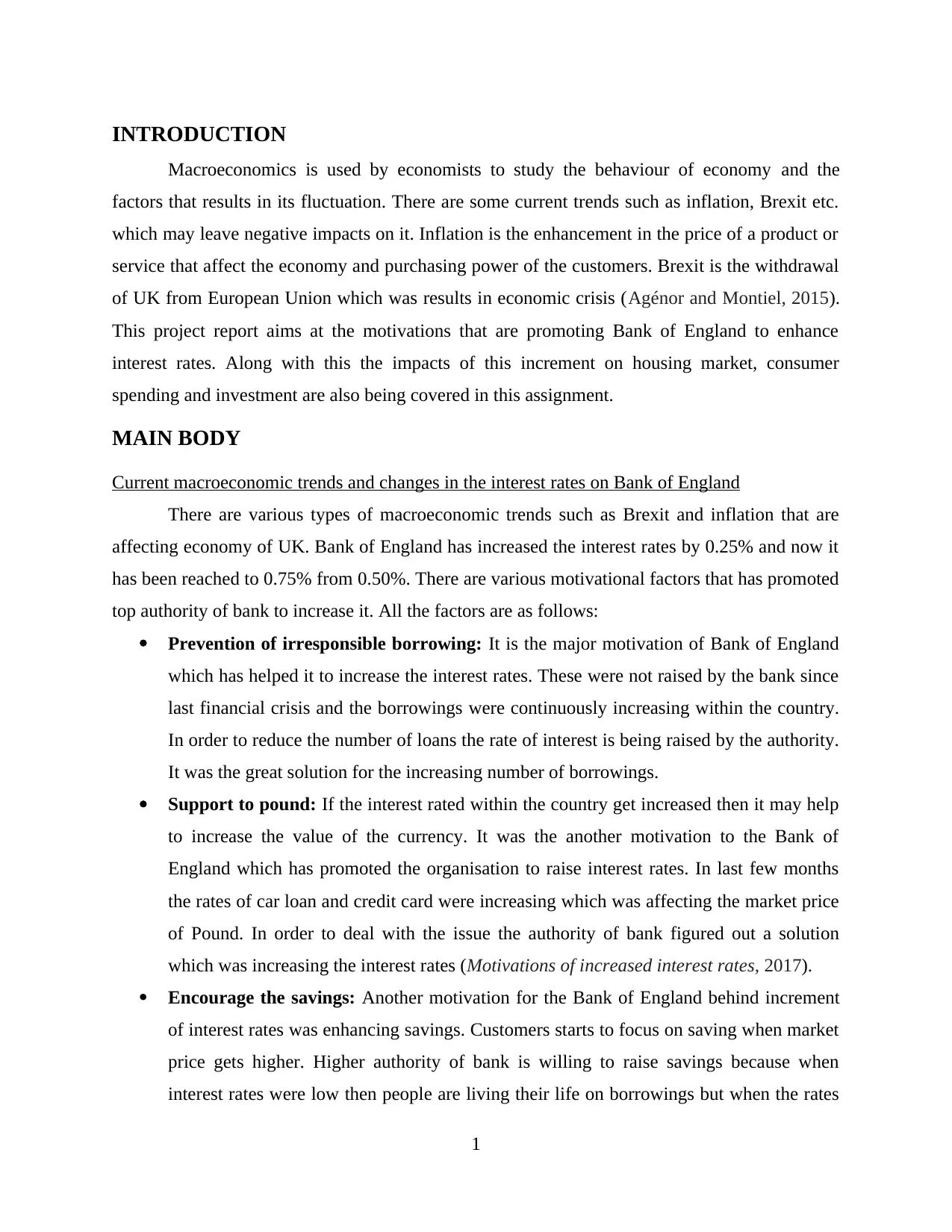
INTRODUCTION
Macroeconomics is used by economists to study the behaviour of economy and the
factors that results in its fluctuation. There are some current trends such as inflation, Brexit etc.
which may leave negative impacts on it. Inflation is the enhancement in the price of a product or
service that affect the economy and purchasing power of the customers. Brexit is the withdrawal
of UK from European Union which was results in economic crisis (Agénor and Montiel, 2015).
This project report aims at the motivations that are promoting Bank of England to enhance
interest rates. Along with this the impacts of this increment on housing market, consumer
spending and investment are also being covered in this assignment.
MAIN BODY
Current macroeconomic trends and changes in the interest rates on Bank of England
There are various types of macroeconomic trends such as Brexit and inflation that are
affecting economy of UK. Bank of England has increased the interest rates by 0.25% and now it
has been reached to 0.75% from 0.50%. There are various motivational factors that has promoted
top authority of bank to increase it. All the factors are as follows:
Prevention of irresponsible borrowing: It is the major motivation of Bank of England
which has helped it to increase the interest rates. These were not raised by the bank since
last financial crisis and the borrowings were continuously increasing within the country.
In order to reduce the number of loans the rate of interest is being raised by the authority.
It was the great solution for the increasing number of borrowings.
Support to pound: If the interest rated within the country get increased then it may help
to increase the value of the currency. It was the another motivation to the Bank of
England which has promoted the organisation to raise interest rates. In last few months
the rates of car loan and credit card were increasing which was affecting the market price
of Pound. In order to deal with the issue the authority of bank figured out a solution
which was increasing the interest rates (Motivations of increased interest rates, 2017).
Encourage the savings: Another motivation for the Bank of England behind increment
of interest rates was enhancing savings. Customers starts to focus on saving when market
price gets higher. Higher authority of bank is willing to raise savings because when
interest rates were low then people are living their life on borrowings but when the rates
1
Macroeconomics is used by economists to study the behaviour of economy and the
factors that results in its fluctuation. There are some current trends such as inflation, Brexit etc.
which may leave negative impacts on it. Inflation is the enhancement in the price of a product or
service that affect the economy and purchasing power of the customers. Brexit is the withdrawal
of UK from European Union which was results in economic crisis (Agénor and Montiel, 2015).
This project report aims at the motivations that are promoting Bank of England to enhance
interest rates. Along with this the impacts of this increment on housing market, consumer
spending and investment are also being covered in this assignment.
MAIN BODY
Current macroeconomic trends and changes in the interest rates on Bank of England
There are various types of macroeconomic trends such as Brexit and inflation that are
affecting economy of UK. Bank of England has increased the interest rates by 0.25% and now it
has been reached to 0.75% from 0.50%. There are various motivational factors that has promoted
top authority of bank to increase it. All the factors are as follows:
Prevention of irresponsible borrowing: It is the major motivation of Bank of England
which has helped it to increase the interest rates. These were not raised by the bank since
last financial crisis and the borrowings were continuously increasing within the country.
In order to reduce the number of loans the rate of interest is being raised by the authority.
It was the great solution for the increasing number of borrowings.
Support to pound: If the interest rated within the country get increased then it may help
to increase the value of the currency. It was the another motivation to the Bank of
England which has promoted the organisation to raise interest rates. In last few months
the rates of car loan and credit card were increasing which was affecting the market price
of Pound. In order to deal with the issue the authority of bank figured out a solution
which was increasing the interest rates (Motivations of increased interest rates, 2017).
Encourage the savings: Another motivation for the Bank of England behind increment
of interest rates was enhancing savings. Customers starts to focus on saving when market
price gets higher. Higher authority of bank is willing to raise savings because when
interest rates were low then people are living their life on borrowings but when the rates
1
⊘ This is a preview!⊘
Do you want full access?
Subscribe today to unlock all pages.

Trusted by 1+ million students worldwide
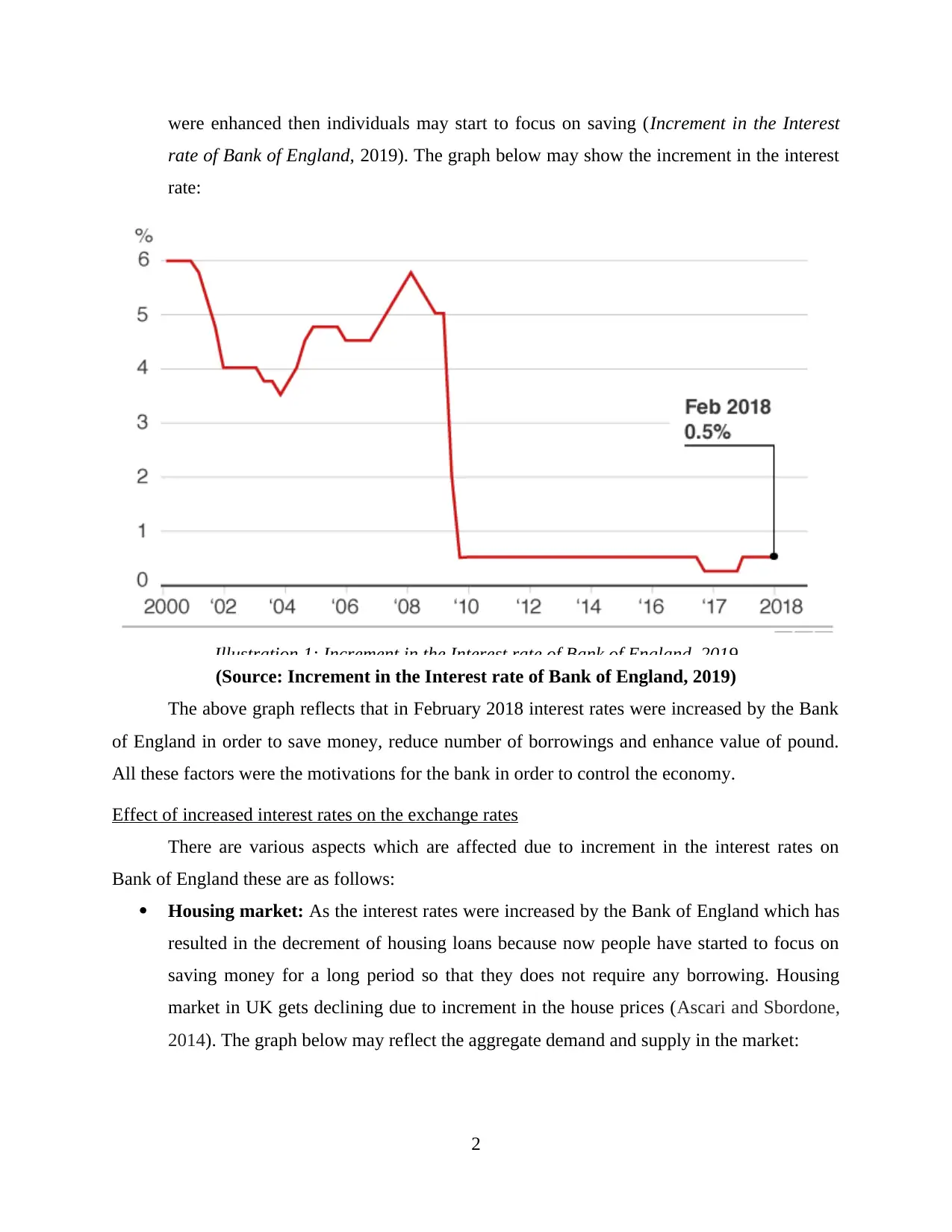
were enhanced then individuals may start to focus on saving (Increment in the Interest
rate of Bank of England, 2019). The graph below may show the increment in the interest
rate:
(Source: Increment in the Interest rate of Bank of England, 2019)
The above graph reflects that in February 2018 interest rates were increased by the Bank
of England in order to save money, reduce number of borrowings and enhance value of pound.
All these factors were the motivations for the bank in order to control the economy.
Effect of increased interest rates on the exchange rates
There are various aspects which are affected due to increment in the interest rates on
Bank of England these are as follows:
Housing market: As the interest rates were increased by the Bank of England which has
resulted in the decrement of housing loans because now people have started to focus on
saving money for a long period so that they does not require any borrowing. Housing
market in UK gets declining due to increment in the house prices (Ascari and Sbordone,
2014). The graph below may reflect the aggregate demand and supply in the market:
2
Illustration 1: Increment in the Interest rate of Bank of England, 2019
rate of Bank of England, 2019). The graph below may show the increment in the interest
rate:
(Source: Increment in the Interest rate of Bank of England, 2019)
The above graph reflects that in February 2018 interest rates were increased by the Bank
of England in order to save money, reduce number of borrowings and enhance value of pound.
All these factors were the motivations for the bank in order to control the economy.
Effect of increased interest rates on the exchange rates
There are various aspects which are affected due to increment in the interest rates on
Bank of England these are as follows:
Housing market: As the interest rates were increased by the Bank of England which has
resulted in the decrement of housing loans because now people have started to focus on
saving money for a long period so that they does not require any borrowing. Housing
market in UK gets declining due to increment in the house prices (Ascari and Sbordone,
2014). The graph below may reflect the aggregate demand and supply in the market:
2
Illustration 1: Increment in the Interest rate of Bank of England, 2019
Paraphrase This Document
Need a fresh take? Get an instant paraphrase of this document with our AI Paraphraser
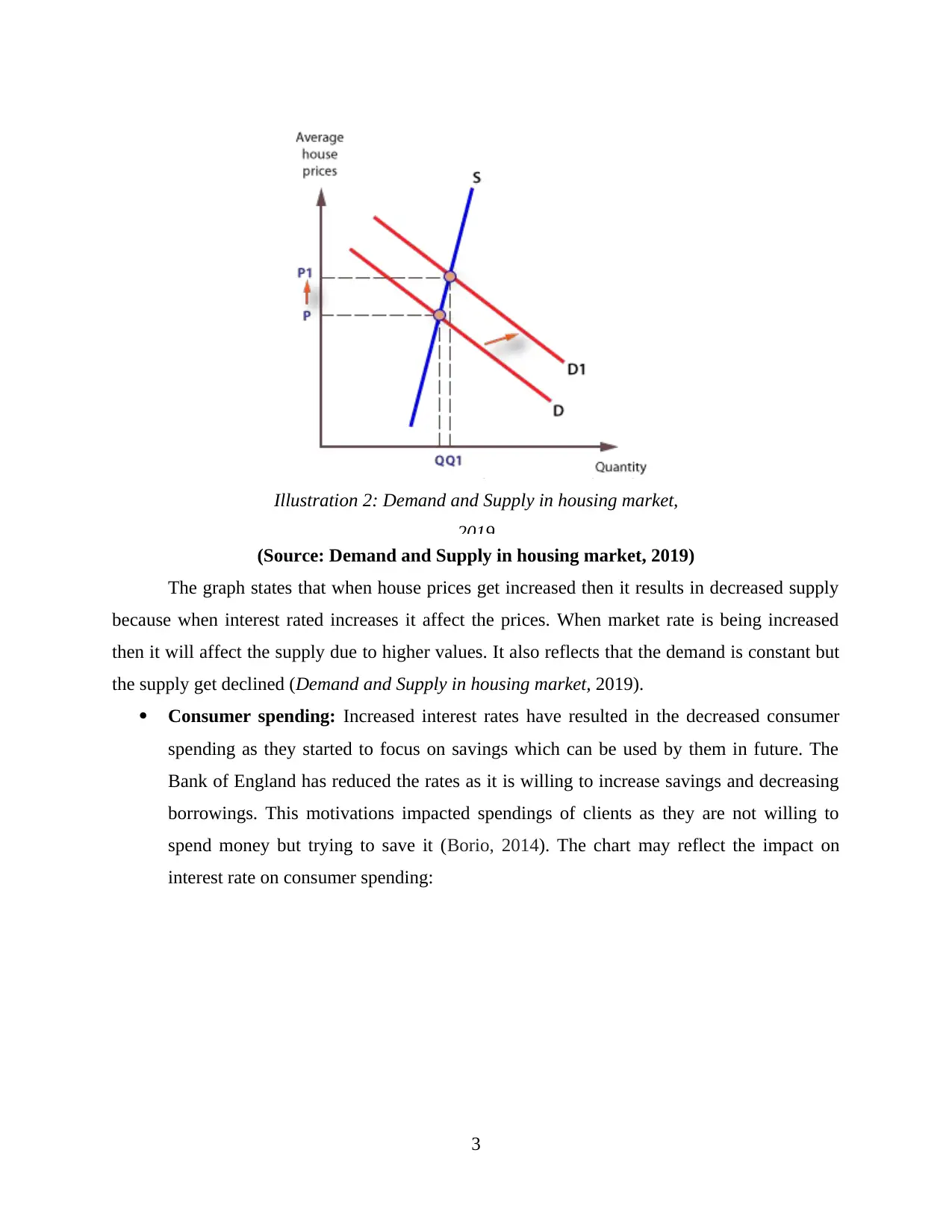
(Source: Demand and Supply in housing market, 2019)
The graph states that when house prices get increased then it results in decreased supply
because when interest rated increases it affect the prices. When market rate is being increased
then it will affect the supply due to higher values. It also reflects that the demand is constant but
the supply get declined (Demand and Supply in housing market, 2019).
Consumer spending: Increased interest rates have resulted in the decreased consumer
spending as they started to focus on savings which can be used by them in future. The
Bank of England has reduced the rates as it is willing to increase savings and decreasing
borrowings. This motivations impacted spendings of clients as they are not willing to
spend money but trying to save it (Borio, 2014). The chart may reflect the impact on
interest rate on consumer spending:
3
Illustration 2: Demand and Supply in housing market,
2019
The graph states that when house prices get increased then it results in decreased supply
because when interest rated increases it affect the prices. When market rate is being increased
then it will affect the supply due to higher values. It also reflects that the demand is constant but
the supply get declined (Demand and Supply in housing market, 2019).
Consumer spending: Increased interest rates have resulted in the decreased consumer
spending as they started to focus on savings which can be used by them in future. The
Bank of England has reduced the rates as it is willing to increase savings and decreasing
borrowings. This motivations impacted spendings of clients as they are not willing to
spend money but trying to save it (Borio, 2014). The chart may reflect the impact on
interest rate on consumer spending:
3
Illustration 2: Demand and Supply in housing market,
2019
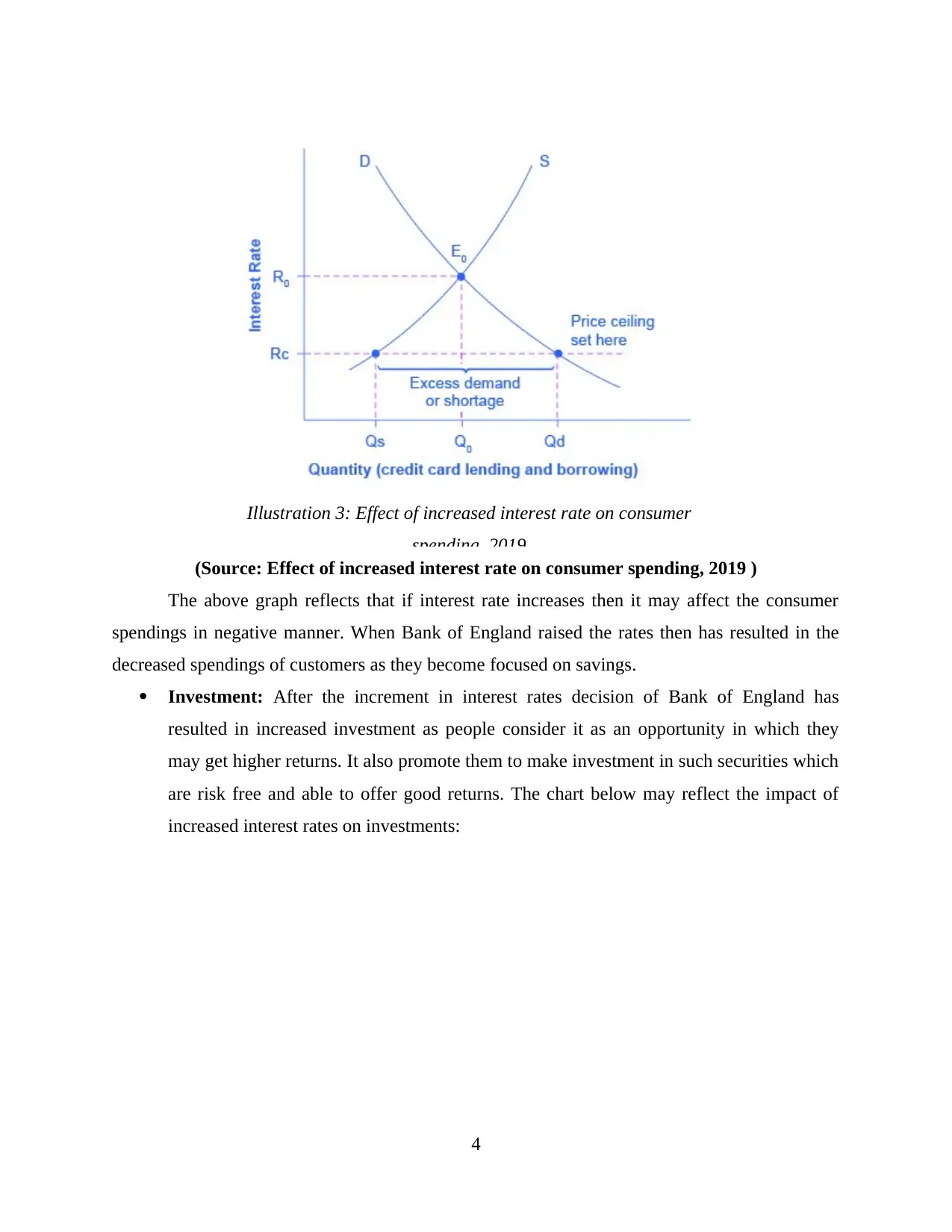
(Source: Effect of increased interest rate on consumer spending, 2019 )
The above graph reflects that if interest rate increases then it may affect the consumer
spendings in negative manner. When Bank of England raised the rates then has resulted in the
decreased spendings of customers as they become focused on savings.
Investment: After the increment in interest rates decision of Bank of England has
resulted in increased investment as people consider it as an opportunity in which they
may get higher returns. It also promote them to make investment in such securities which
are risk free and able to offer good returns. The chart below may reflect the impact of
increased interest rates on investments:
4
Illustration 3: Effect of increased interest rate on consumer
spending, 2019
The above graph reflects that if interest rate increases then it may affect the consumer
spendings in negative manner. When Bank of England raised the rates then has resulted in the
decreased spendings of customers as they become focused on savings.
Investment: After the increment in interest rates decision of Bank of England has
resulted in increased investment as people consider it as an opportunity in which they
may get higher returns. It also promote them to make investment in such securities which
are risk free and able to offer good returns. The chart below may reflect the impact of
increased interest rates on investments:
4
Illustration 3: Effect of increased interest rate on consumer
spending, 2019
⊘ This is a preview!⊘
Do you want full access?
Subscribe today to unlock all pages.

Trusted by 1+ million students worldwide
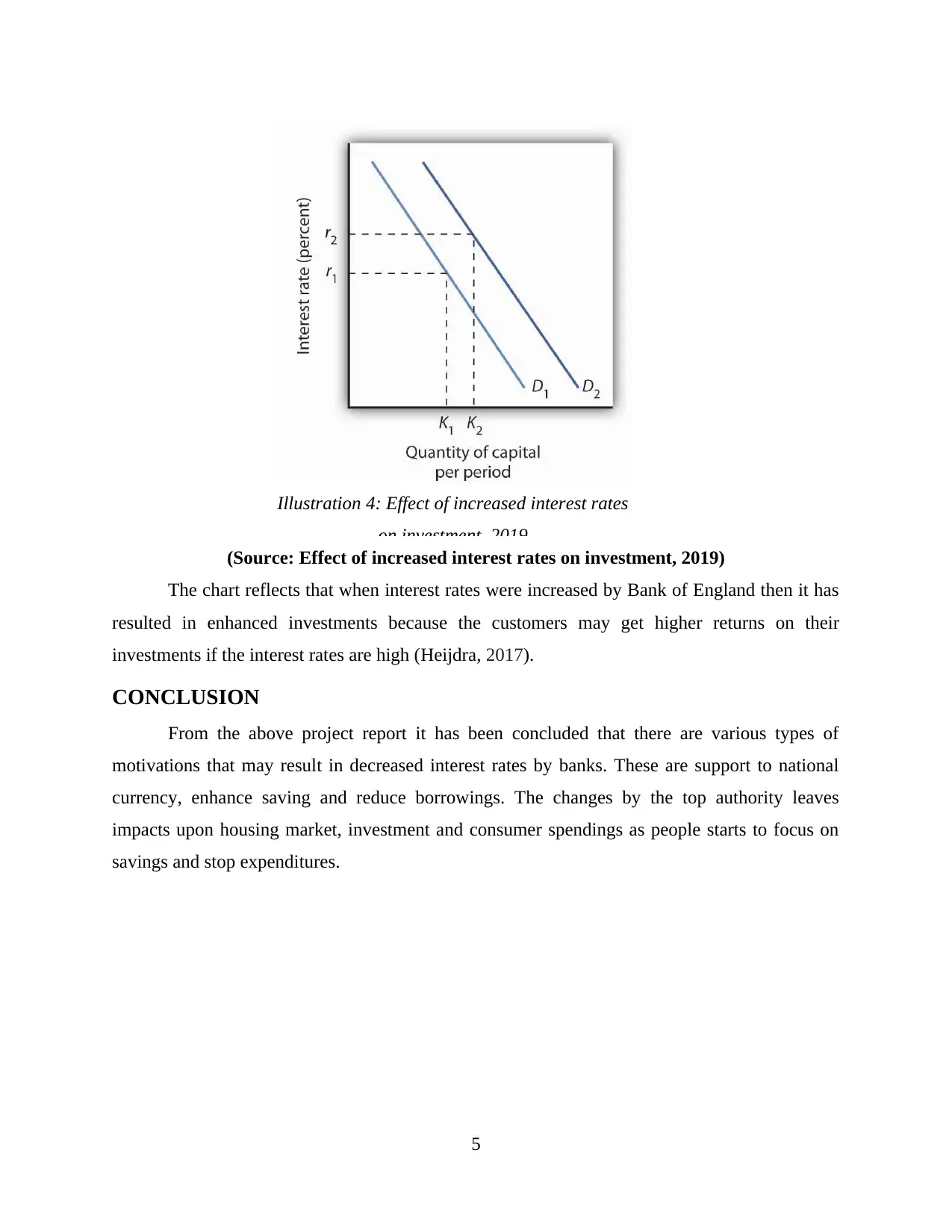
(Source: Effect of increased interest rates on investment, 2019)
The chart reflects that when interest rates were increased by Bank of England then it has
resulted in enhanced investments because the customers may get higher returns on their
investments if the interest rates are high (Heijdra, 2017).
CONCLUSION
From the above project report it has been concluded that there are various types of
motivations that may result in decreased interest rates by banks. These are support to national
currency, enhance saving and reduce borrowings. The changes by the top authority leaves
impacts upon housing market, investment and consumer spendings as people starts to focus on
savings and stop expenditures.
5
Illustration 4: Effect of increased interest rates
on investment, 2019
The chart reflects that when interest rates were increased by Bank of England then it has
resulted in enhanced investments because the customers may get higher returns on their
investments if the interest rates are high (Heijdra, 2017).
CONCLUSION
From the above project report it has been concluded that there are various types of
motivations that may result in decreased interest rates by banks. These are support to national
currency, enhance saving and reduce borrowings. The changes by the top authority leaves
impacts upon housing market, investment and consumer spendings as people starts to focus on
savings and stop expenditures.
5
Illustration 4: Effect of increased interest rates
on investment, 2019
Paraphrase This Document
Need a fresh take? Get an instant paraphrase of this document with our AI Paraphraser
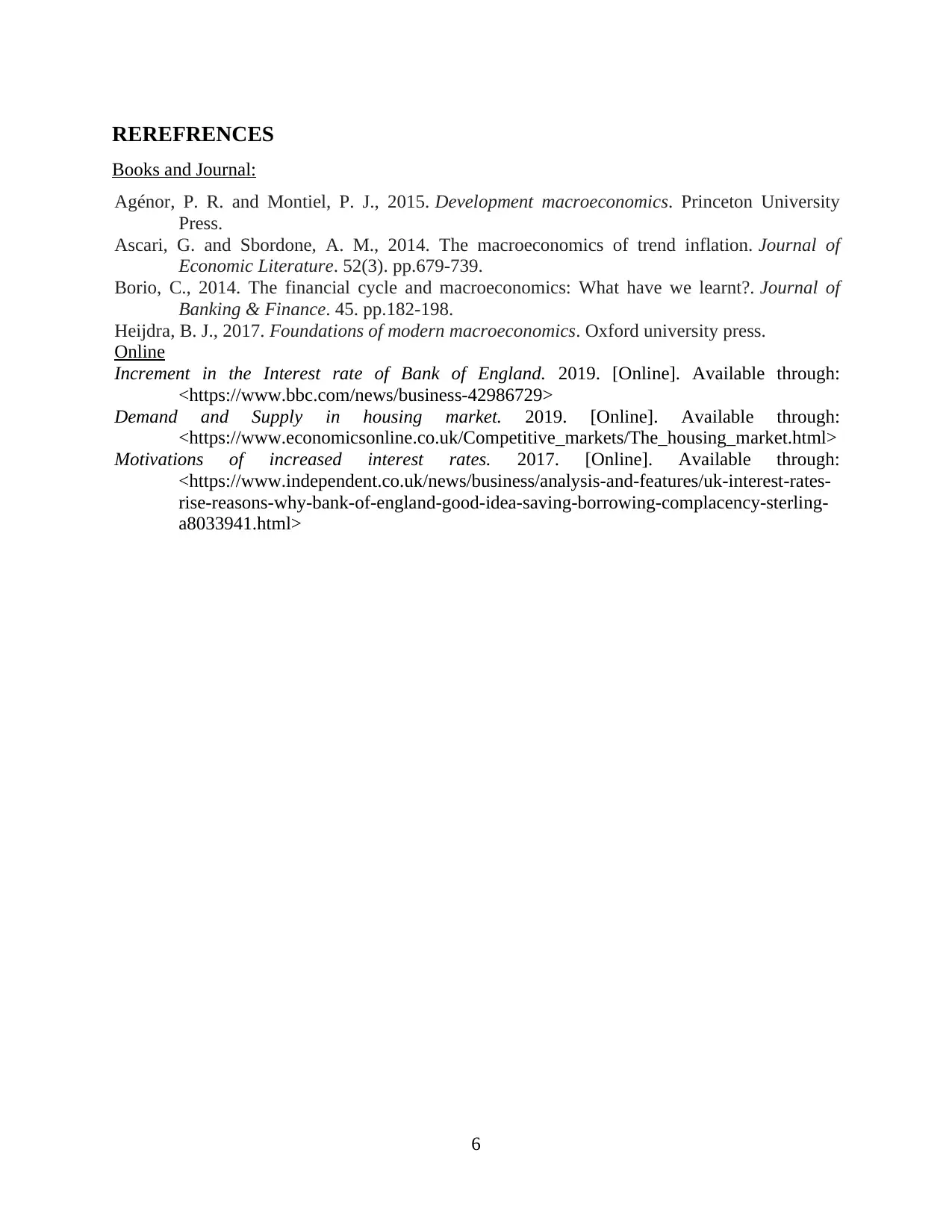
REREFRENCES
Books and Journal:
Agénor, P. R. and Montiel, P. J., 2015. Development macroeconomics. Princeton University
Press.
Ascari, G. and Sbordone, A. M., 2014. The macroeconomics of trend inflation. Journal of
Economic Literature. 52(3). pp.679-739.
Borio, C., 2014. The financial cycle and macroeconomics: What have we learnt?. Journal of
Banking & Finance. 45. pp.182-198.
Heijdra, B. J., 2017. Foundations of modern macroeconomics. Oxford university press.
Online
Increment in the Interest rate of Bank of England. 2019. [Online]. Available through:
<https://www.bbc.com/news/business-42986729>
Demand and Supply in housing market. 2019. [Online]. Available through:
<https://www.economicsonline.co.uk/Competitive_markets/The_housing_market.html>
Motivations of increased interest rates. 2017. [Online]. Available through:
<https://www.independent.co.uk/news/business/analysis-and-features/uk-interest-rates-
rise-reasons-why-bank-of-england-good-idea-saving-borrowing-complacency-sterling-
a8033941.html>
6
Books and Journal:
Agénor, P. R. and Montiel, P. J., 2015. Development macroeconomics. Princeton University
Press.
Ascari, G. and Sbordone, A. M., 2014. The macroeconomics of trend inflation. Journal of
Economic Literature. 52(3). pp.679-739.
Borio, C., 2014. The financial cycle and macroeconomics: What have we learnt?. Journal of
Banking & Finance. 45. pp.182-198.
Heijdra, B. J., 2017. Foundations of modern macroeconomics. Oxford university press.
Online
Increment in the Interest rate of Bank of England. 2019. [Online]. Available through:
<https://www.bbc.com/news/business-42986729>
Demand and Supply in housing market. 2019. [Online]. Available through:
<https://www.economicsonline.co.uk/Competitive_markets/The_housing_market.html>
Motivations of increased interest rates. 2017. [Online]. Available through:
<https://www.independent.co.uk/news/business/analysis-and-features/uk-interest-rates-
rise-reasons-why-bank-of-england-good-idea-saving-borrowing-complacency-sterling-
a8033941.html>
6
1 out of 8
Related Documents
Your All-in-One AI-Powered Toolkit for Academic Success.
+13062052269
info@desklib.com
Available 24*7 on WhatsApp / Email
![[object Object]](/_next/static/media/star-bottom.7253800d.svg)
Unlock your academic potential
Copyright © 2020–2025 A2Z Services. All Rights Reserved. Developed and managed by ZUCOL.




